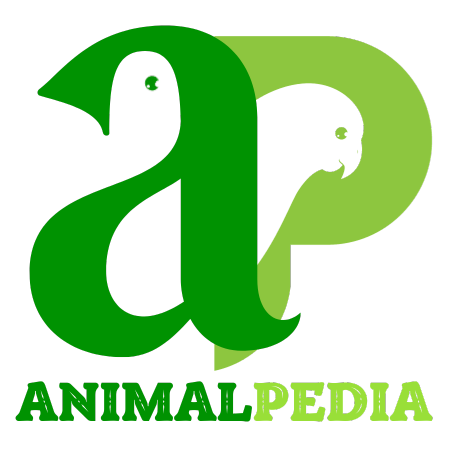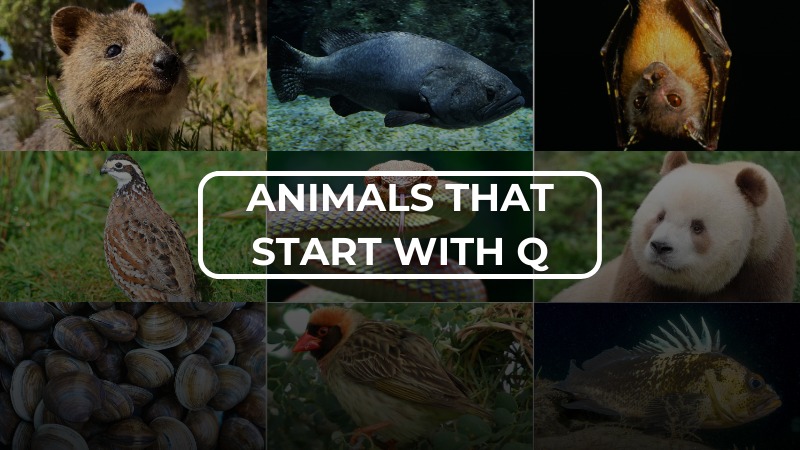Most Popular Animals Start With Q
The animal kingdom never ceases to amaze, offering endless discoveries of unique and fascinating creatures. Today, we’re focusing on animals that start with the letter ‘Q.’ From the quirky Quokka to the elusive Quail, these remarkable species showcase the incredible diversity of life on Earth. Whether you’re a student, a nature enthusiast, or simply curious, this list of animals beginning with ‘Q’ will spark your interest and deepen your appreciation for the wonders of nature!
| Quail | Queen Snake | Quaker Parrot |
| Quahog Clam | Quick-footed Gecko | Queen Angelfish |
| Quoll | Quetzal | Quokka |
| Queensland Grouper |
1. Quail
Quails, scientifically categorized under the family Phasianidae, share their lineage with pheasants, partridges, and chickens. These small birds vary in size depending on the species, with lengths of 4.7–11 inches (0.12–0.28 meters) and weights of 2.5–9 ounces (70–250 grams). They are widely distributed, inhabiting grasslands, forests, and agricultural fields across North America, Europe, Asia, and Africa. Their adaptability allows them to thrive in diverse climates, ranging from temperate to tropical. Some species, such as the Common Quail (Coturnix coturnix), even migrate long distances for breeding and wintering.
Quails have unique features suited for their ground-dwelling lifestyle. Their plumage, in earthy tones with speckled patterns, provides excellent camouflage. With short wings and tails, they are better suited for brief flights. Omnivorous by nature, quails forage on the ground, feeding on seeds, grains, and insects. Social creatures, they live in small groups called coveys and are active during the day, alternating between foraging and resting.
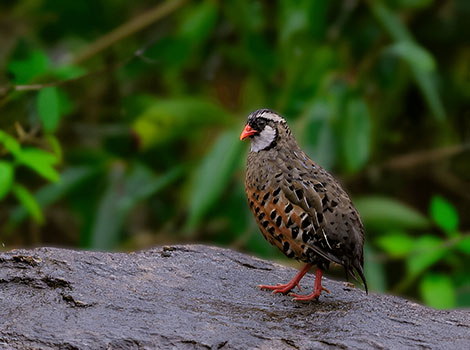
| Attributes | Quick facts |
|---|---|
| Size | 4.7–11 in (12–28 cm), depending on species |
| Weight | 2.5–9 oz (70–250 g) |
| Lifespan | 2–5 years in the wild, up to 8 years in captivity |
| Habitat | Grasslands, forests, and agricultural fields worldwide |
| Diet | Seeds, grains, and insects |
| Social Structure | Lives in small coveys (groups) |
| Conservation | Least Concern |
Fun Fact: The Common Quail’s call, described in English folklore as “wet-my-lips,” is both charming and practical, used to attract mates and signal danger!
2. Queen Snake
The Queen Snake (Regina septemvittata), a non-venomous member of the Colubridae family, is a slender reptile found in freshwater habitats like streams and rivers with rocky bottoms across the eastern United States and Canada. Measuring 15–36 inches (0.38–0.91 meters) in length and weighing 5–14 ounces (140–400 grams), this snake thrives in temperate climates and clean, flowing water. While non-migratory, it may move along waterways in search of food or shelter.
This snake is easily recognized by its olive-brown to dark gray dorsal color and four dark stripes along its lighter belly. Its keeled scales provide grip in aquatic settings, and its prehensile tail helps it navigate rocky streambeds. The Queen Snake’s diet is highly specialized, focusing on soft, freshly molted crayfish. Active during the day, it spends time basking near water or hiding under rocks and gives birth to live young, which are independent from birth.
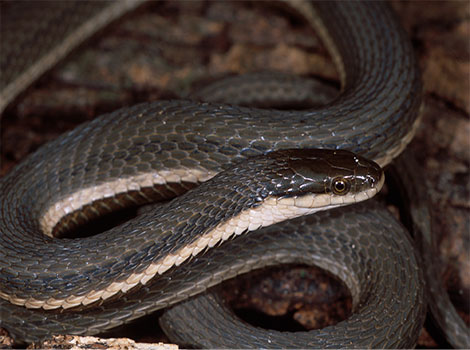
| Attributes | Quick facts |
|---|---|
| Size | 15–36 in (38–91 cm) |
| Weight | 5–14 oz (140–400 g) |
| Lifespan | 15–20 years |
| Habitat | Streams and rivers with rocky bottoms in the eastern United States and Canada |
| Diet | Primarily crayfish, especially recently molted ones |
| Social Structure | Solitary |
| Conservation | Least Concern |
Fun Fact: The Queen Snake serves as a bioindicator species, signaling healthy, unpolluted freshwater systems essential for its survival!
3. Quaker Parrot
The Quaker Parrot (Myiopsitta monachus), also known as the Monk Parakeet, is a medium-sized bird from the family Psittacidae, which includes parrots and parakeets. Measuring 11–12 inches (0.28–0.30 meters) long and weighing 3–5 ounces (90–140 grams), it has bright green plumage, a grayish chest, and a long, pointed tail. Native to South America, particularly Argentina and Brazil, this adaptable species thrives in temperate and subtropical climates and has established feral populations in North America, Europe, and Asia, even in colder regions.
Quaker Parrots are highly social, living in large flocks and forming communal nests. They forage on seeds, fruits, and vegetables, often in trees or agricultural fields. Breeding takes place in their impressive nests, with females laying 4–8 eggs that hatch after about 24 days. Both parents care for the chicks, which fledge at 6–7 weeks of age.
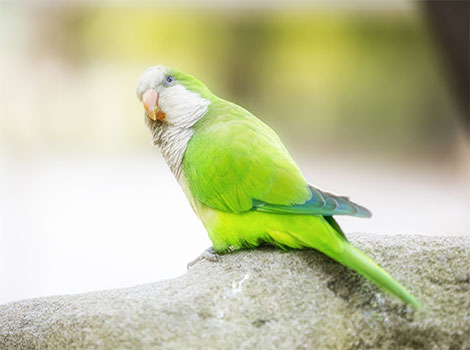
| Attributes | Quick facts |
|---|---|
| Size | 11–12 in (28–30 cm) |
| Weight | 3–5 oz (90–140 g) |
| Lifespan | 20–30 years |
| Habitat | Native to South America; adaptable to urban and suburban areas worldwide |
| Diet | Seeds, fruits, vegetables, and nuts |
| Social Structure | Highly social; lives in flocks and builds large communal nests |
| Conservation | Least Concern |
Fun Fact: Unlike other parrots, Quaker Parrots build elaborate, multi-chambered nests out of twigs that can house several pairs of birds in one structure!
4. Quahog Clam
The Quahog Clam (Mercenaria mercenaria or Arctica islandica for exceptionally long-lived species) is a member of the family Veneridae, also known as venus clams. These marine bivalves measure 2.8–4.3 inches (7–11 centimeters) in length and weigh up to 0.5 pounds (225 grams). Found along the Atlantic coast from Canada’s Gulf of St. Lawrence to Florida, they thrive in temperate, shallow marine environments with sandy or muddy substrates. Non-migratory, they remain buried in sediment for most of their lives.
With thick, grayish-white shells marked by concentric growth rings, Quahog Clams are built for burrowing and protection. They feed passively by filtering microscopic plankton and organic particles from water drawn in through siphons. Solitary by nature, they stay buried except for exposed siphons used for feeding and respiration. Their reproductive strategy involves releasing eggs and sperm into the water, with free-swimming larvae settling as independent juveniles.
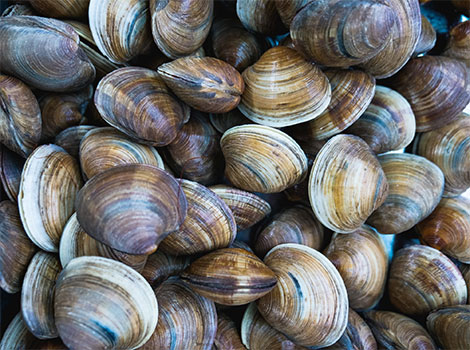
| Attributes | Quick facts |
|---|---|
| Size | 2.8–4.3 in (7–11 cm), can grow larger |
| Weight | Up to 0.5 lbs (225 g) |
| Lifespan | 40–50 years, some over 200 years (e.g., Arctica islandica) |
| Habitat | Sandy and muddy coastal waters of the Atlantic Ocean |
| Diet | Filter feeder; consumes plankton and organic particles |
| Social Structure | Solitary |
| Conservation | Least Concern |
Fun Fact: The Arctica islandica species of Quahog Clam holds the record for longevity, with some individuals living over 200 years!
5. Quick-footed Gecko
The Quick-footed Gecko (Mediodactylus spp.) is a small member of the family Gekkonidae, known for its agility and adaptability. Measuring 2.4–4 inches (6–10 centimeters) in length and weighing under 0.5 ounces (15 grams), this gecko inhabits arid and semi-arid regions, including deserts and rocky terrains in Central Asia and the Middle East. Thriving in hot, dry climates, it is non-migratory but moves locally in search of food and shelter.
This gecko’s light tan to gray coloration, often marked with dark spots or bands, provides excellent camouflage in sandy or rocky environments. Its adhesive toe pads enable it to climb vertical surfaces, and its tail can detach to distract predators, regenerating later. A nocturnal insectivore, it hunts small insects and invertebrates with incredible speed and agility. Solitary by nature, it rests in crevices or burrows during the day to avoid the desert heat.
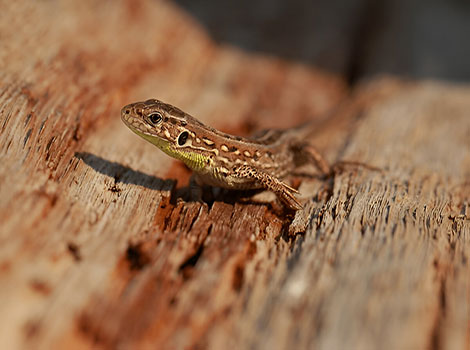
| Attributes | Quick facts |
|---|---|
| Size | 2.4–4 in (6–10 cm) |
| Weight | Less than 0.5 oz (under 15 g) |
| Lifespan | 5–10 years |
| Habitat | Arid and semi-arid regions, including deserts and scrublands in Central Asia and the Middle East |
| Diet | Insects and small invertebrates |
| Social Structure | Solitary |
| Conservation | Least Concern |
Fun Fact: True to its name, the Quick-footed Gecko’s speed helps it navigate harsh desert environments and escape predators with ease!
6. Queen Angelfish
The Queen Angelfish (Holacanthus ciliaris), a vibrant member of the family Pomacanthidae, is a stunning inhabitant of coral reefs and rocky areas in the western Atlantic Ocean, including the Caribbean Sea, Gulf of Mexico, and Florida Keys. Ranging in size from 8–14 inches (20–35 centimeters) and weighing 1–3 pounds (0.5–1.4 kilograms), it thrives in warm tropical waters at depths of 3–230 feet (1–70 meters). These non-migratory fish stay close to their reef habitats.
Easily recognized by their bright blue and yellow bodies, Queen Angelfish feature a blue crown-like marking on their foreheads and yellow-edged fins. They primarily feed on sponges but also consume algae and small invertebrates, using their pointed mouths to forage in coral crevices. Active during the day, they spend time feeding or patrolling territories, often appearing solitary or in pairs, especially during the breeding season.
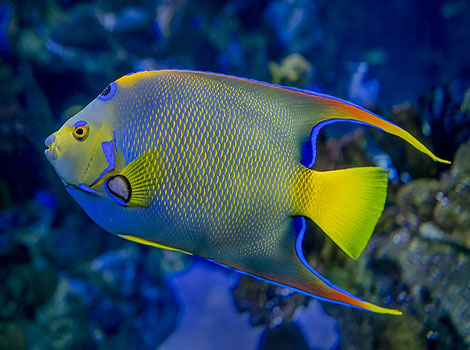
| Attributes | Quick facts |
|---|---|
| Size | 8–14 in (20–35 cm); can grow up to 18 in (45 cm) |
| Weight | 1–3 lbs (0.5–1.4 kg) |
| Lifespan | 10–15 years |
| Habitat | Coral reefs and rocky areas in the western Atlantic Ocean, including the Caribbean Sea and Gulf of Mexico |
| Diet | Sponges, algae, and small invertebrates |
| Social Structure | Solitary or in pairs |
| Conservation | Least Concern |
Fun Fact: Queen Angelfish are known for forming long-term monogamous bonds, a unique trait among reef fish!
7. Quoll
Quolls (Dasyurus spp.), carnivorous marsupials in the family Dasyuridae, are found in forests, grasslands, and savannas across Australia, Tasmania, and New Guinea. Depending on the species, they range from 10–29 inches (0.25–0.75 meters) in length and weigh between 1–15 pounds (0.5–7 kilograms). Adapted to temperate, tropical, and subtropical climates, quolls are non-migratory but roam within their habitats to find prey and shelter.
With brown to black fur covered in white spots, quolls are well-camouflaged. They have sharp teeth, a pointed snout, and a long tail for balance. Nocturnal hunters, quolls prey on small mammals, birds, reptiles, insects, and carrion, using keen senses of smell and sight. Solitary by nature, they rest in dens during the day and are active at night. Females give birth to 6–8 underdeveloped young, which stay in the pouch and later in a den until weaning.
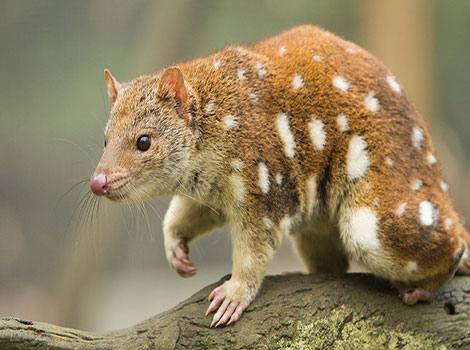
| Attributes | Quick facts |
|---|---|
| Size | 10–29 in (25–75 cm), depending on species |
| Weight | 1–15 lbs (0.5–7 kg), varies by species |
| Lifespan | 2–5 years in the wild, up to 7 years in captivity |
| Habitat | Forests, grasslands, and savannas in Australia, New Guinea, and Tasmania |
| Diet | Carnivorous; small mammals, birds, insects, and carrion |
| Social Structure | Solitary |
| Conservation | Near Threatened |
Fun Fact: Agile and adaptable, quolls are skilled climbers that scale trees to hunt birds or escape predators!
8. Quetzal
The Quetzal (Pharomachrus mocinno), a vibrant bird in the family Trogonidae, is native to tropical and subtropical forests in Central America, particularly the cloud forests of southern Mexico to Panama. Measuring 14–16 inches (0.36–0.40 meters) in length and weighing 7–8 ounces (200–225 grams), males are distinguished by trailing tail feathers that can reach 26 inches (0.66 meters). Preferring cool, humid environments, Quetzals are non-migratory but may move locally for food or during breeding.
With shimmering green and red plumage, males use their elongated tail feathers in mating displays. Quetzals forage in the canopy, feeding on fruits like wild avocados and occasionally insects or small prey. They are typically solitary but form pairs for breeding, nesting in tree cavities where both parents incubate eggs and feed chicks with regurgitated food until fledging at three weeks.
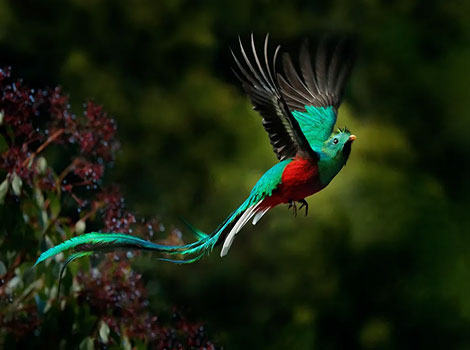
| Attributes | Quick facts |
|---|---|
| Size | 14–16 in (36–40 cm); males have tail feathers up to 26 in (66 cm) |
| Weight | 7–8 oz (200–225 g) |
| Lifespan | 20–25 years |
| Habitat | Tropical and subtropical forests in Central America |
| Diet | Fruits, insects, and small vertebrates |
| Social Structure | Solitary or pairs during breeding season |
| Conservation | Near Threatened |
Fun Fact: The Resplendent Quetzal, revered by ancient Maya and Aztec civilizations, symbolized freedom and beauty, with its tail feathers once used as currency and ceremonial treasures!
9. Quokka
The Quokka (Setonix brachyurus), a member of the Macropodidae family, is a small marsupial related to kangaroos and wallabies. Measuring 16–21 inches (0.40–0.54 meters) in body length and weighing 5.5–11 pounds (2.5–5 kilograms), Quokkas are native to islands off Western Australia, including Rottnest and Bald Island, with small populations on the mainland. They inhabit forests, scrublands, and grasslands, preferring temperate climates with dense vegetation for shade and shelter.
Quokkas are nocturnal and primarily solitary, foraging for grasses, leaves, and fruits at night. Their brownish-gray fur, rounded body, and signature “smiling” facial features give them an endearing appearance. Females carry a single joey in their forward-facing pouch for about six months. Remarkably, if a joey is lost, females can use a delayed-implantation mechanism to produce another.
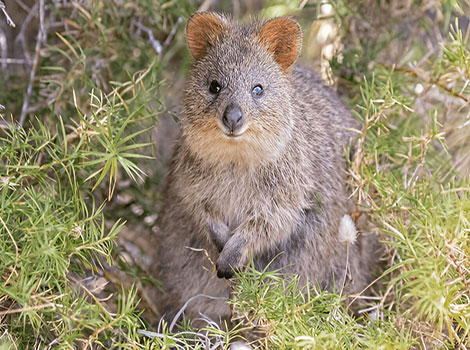
| Attributes | Quick facts |
|---|---|
| Size | 16–21 in (40–54 cm) body; tail 9–12 in (23–31 cm) |
| Weight | 5.5–11 lbs (2.5–5 kg) |
| Lifespan | 10–15 years |
| Habitat | Forests, scrublands, and grasslands on islands off Western Australia, including Rottnest Island |
| Diet | Herbivorous; grasses, leaves, and fruits |
| Social Structure | Loose groups; primarily solitary but tolerant of others |
| Conservation | Vulnerable |
Fun Fact: Known as “the world’s happiest animal,” Quokkas are famed for their cheerful expressions, making them a favorite for selfies with visitors on Rottnest Island!
10. Queensland Grouper
The Queensland Grouper (Epinephelus lanceolatus), the largest bony fish found in coral reefs, belongs to the Serranidae family, which includes groupers and sea bass. Reaching lengths of up to 8.9 feet (2.7 meters) and weighing as much as 880 pounds (400 kilograms), these giants inhabit coral reefs, rocky coastal areas, and estuaries throughout the Indo-Pacific, especially around Queensland, Australia. They thrive in tropical and subtropical waters, staying local but moving between habitats for feeding or reproduction.
With grayish-brown bodies marked by pale spots and bands, Queensland Groupers camouflage effectively in reef environments. Their robust bodies, broad heads, and massive mouths enable them to swallow prey whole. As ambush predators, they feed on fish, crustaceans, and even small sharks. Solitary by nature, they are active both day and night, with peak feeding times at dawn and dusk.
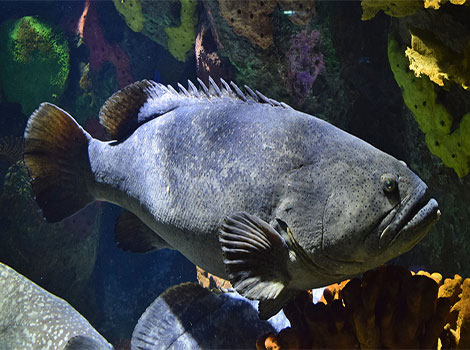
| Attributes | Quick facts |
|---|---|
| Size | Up to 8.9 ft (2.7 m) |
| Weight | Up to 880 lbs (400 kg) |
| Lifespan | 30–50 years |
| Habitat | Coral reefs and rocky coastal areas in the Indo-Pacific region, including Queensland, Australia |
| Diet | Carnivorous; fish, crustaceans, and cephalopods |
| Social Structure | Solitary |
| Conservation | Vulnerable |
Fun Fact: These impressive fish can create a powerful suction with their wide mouths, pulling prey in from several feet away!
After exploring the broad array of popular animals starting with ‘Q,’ it’s time to narrow our focus to mammals. These warm-blooded creatures captivate with their intelligence and adaptability.
Mammals that start with Q
Mammals starting with ‘Q’ include a fascinating variety of species like the quokka and quoll. These creatures thrive in distinct ecosystems and demonstrate remarkable adaptability.
| Quechuan Hocicudo | Quiara Spiny Rat | Queensland Ring-tail Possum |
| Queensland Tube-nosed Bat | Queretaro Pocket Gopher | Queensland Rat Kangaroos |
| Qinling Panda |
11. Quechuan Hocicudo
The Quechuan Hocicudo (Oxymycterus paramensis) is a small rodent in the Cricetidae family, which includes voles, lemmings, and hamsters. It measures 4–6 inches (10–15 centimeters) in body length with a tail of 3–5 inches (8–12 centimeters) and weighs 1–2 ounces (30–60 grams). Found in the high-altitude grasslands and forests of the Andes Mountains, particularly in Bolivia, this rodent thrives in cool, temperate climates at elevations exceeding 3,000 meters.
With brownish to gray fur and a lighter underbelly, the Quechuan Hocicudo blends seamlessly into its grassy or rocky surroundings. Its long, pointed snout is well-adapted for digging and foraging, while its slender tail aids in balance. Omnivorous, it feeds on seeds, fruits, and insects, foraging on the forest floor or grasslands, often during twilight to avoid predators. Though little is known about its reproduction, similar species have multiple litters yearly.
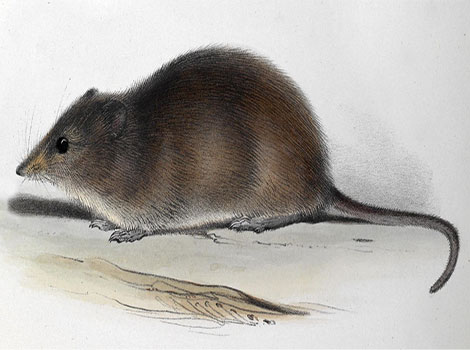
| Attributes | Quick facts |
|---|---|
| Size | 4–6 in (10–15 cm) body; tail 3–5 in (8–12 cm) |
| Weight | 1–2 oz (30–60 g) |
| Lifespan | Estimated 1–2 years |
| Habitat | High-altitude grasslands and forests in the Andes Mountains |
| Diet | Seeds, fruits, and small invertebrates |
| Social Structure | Solitary |
| Conservation | Data Deficient |
Fun Fact: The Quechuan Hocicudo’s distinctive long snout is a key adaptation for survival in its high-altitude habitat, setting it apart from other rodents!
12. Quiara Spiny Rat
The Quiara Spiny Rat (Proechimys spp.), a member of the Echimyidae family, is a medium-sized rodent native to South America. Measuring 8–10 inches (20–25 centimeters) in body length and weighing 0.9–1.3 pounds (400–600 grams), it thrives in tropical rainforests and scrublands with warm, humid climates. Non-migratory by nature, these rodents establish stable home ranges in their habitats.
With brownish to gray fur and spiny hairs along their backs, Quiara Spiny Rats are well-equipped for defense, using their stiff bristles to deter predators. They are herbivorous, foraging for fruits, seeds, and plant material on the ground and in low vegetation, often storing food in burrows. Nocturnal and primarily solitary, they may form small family groups during breeding. Females give birth to 2–4 relatively independent young after a gestation of about two months.
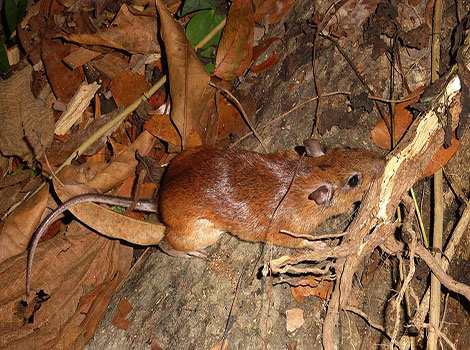
| Attributes | Quick facts |
|---|---|
| Size | 8–10 in (20–25 cm) body length; tail 6–8 in (15–20 cm) |
| Weight | 0.9–1.3 lbs (400–600 g) |
| Lifespan | 3–5 years (estimated) |
| Habitat | Forested and scrubland regions in South America |
| Diet | Fruits, seeds, and plant material |
| Social Structure | Solitary or small family groups |
| Conservation | Least Concern |
Fun Fact: Though armed with spiny fur for defense, Quiara Spiny Rats are not aggressive, relying on their prickly coat to discourage predators!
13. Queensland Ring-tale Possum
The Queensland Ringtail Possum (Pseudochirulus herbertensis) is an arboreal marsupial in the family Pseudocheiridae, native to the rainforests and eucalyptus woodlands of Queensland, Australia. Measuring 12–16 inches (30–40 centimeters) in body and tail length, and weighing 1.5–2.5 pounds (0.7–1.2 kilograms), it thrives in warm, humid environments with dense tree cover. Non-migratory by nature, these possums stay within their established home ranges.
With soft gray to brown fur, a white underside, and a prehensile tail, this medium-sized possum is adapted for life in the canopy. It forages at night on leaves, fruits, and flowers, using sharp claws and its tail for climbing. Social by nature, they live in small family groups and rest in tree hollows or leafy nests during the day. After a brief gestation of 16–18 days, females rear 1–2 young, which develop in the pouch and later ride on their mother’s back.
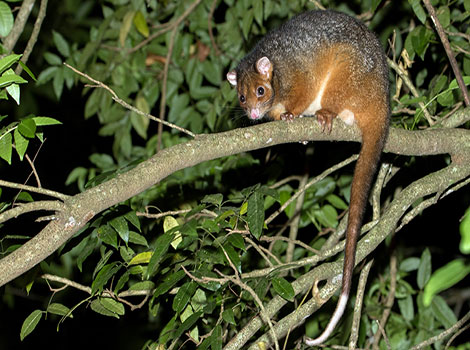
| Attributes | Quick facts |
|---|---|
| Size | 12–16 in (30–40 cm) body; tail 12–16 in (30–40 cm) |
| Weight | 1.5–2.5 lbs (0.7–1.2 kg) |
| Lifespan | 6–10 years |
| Habitat | Rainforests and eucalyptus woodlands in Queensland, Australia |
| Diet | Leaves, fruits, and flowers |
| Social Structure | Lives in small family groups |
| Conservation | Least Concern |
Fun Fact: The Queensland Ringtail Possum’s efficient digestive system allows it to extract maximum nutrients from fibrous leaves, supporting its treetop lifestyle!
14. Queensland Tube-nosed Bat
The Queensland Tube-nosed Bat (Nyctimene robinsoni), a member of the Pteropodidae family, is a small fruit bat native to the rainforests of Queensland, Australia, and nearby islands. Measuring 3–4 inches (7.5–10 centimeters) in body length with a wingspan of about 12 inches (30 centimeters), it weighs only 0.4–0.7 ounces (12–20 grams). These bats thrive in warm, humid tropical climates, moving locally to follow seasonal fruiting patterns.
Known for its light brown to olive-green fur and yellow-spotted wings, this bat has a distinctive tube-shaped snout that aids in locating fruit and nectar. A frugivorous feeder, it uses its keen sense of smell to find ripe figs and flowers, flying short distances between feeding sites. Solitary or loosely social, it roosts in tree canopies during the day and forages at night. Females typically give birth to a single pup annually, which clings to the mother while she feeds.
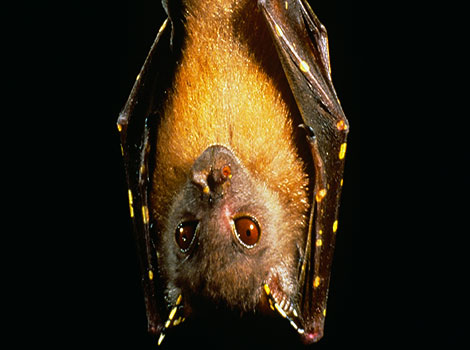
| Attributes | Quick facts |
|---|---|
| Size | 3–4 in (7.5–10 cm) body length; wingspan around 12 in (30 cm) |
| Weight | 0.4–0.7 oz (12–20 g) |
| Lifespan | 5–10 years (estimated) |
| Habitat | Rainforests in Queensland, Australia, and nearby islands |
| Diet | Frugivorous; primarily fruits and nectar |
| Social Structure | Solitary or small groups |
| Conservation | Near Threatened |
Fun Fact: The Queensland Tube-nosed Bat’s unique nostrils, resembling small tubes, give it the endearing nickname “straw-nosed bat”!
15. Queretaro Pocket Gopher
The Queretaro Pocket Gopher (Cratogeomys fulvescens) is a burrowing rodent in the family Geomyidae, known for its fossorial lifestyle. Measuring 8–12 inches (20–30 centimeters) in length and weighing 0.8–1.5 pounds (350–700 grams), it inhabits the grasslands and agricultural fields of Querétaro, Mexico. These gophers prefer temperate climates with loose, fertile soil that supports their extensive burrow systems.
With brownish-gray fur matching the soil and lighter undersides, Queretaro Pocket Gophers have compact bodies, powerful forelimbs, and sharp incisors designed for digging. They feed on roots, tubers, and vegetation, pulling food into their burrows using their external cheek pouches. Solitary by nature, these gophers create intricate tunnel networks and remain underground most of the time. Females breed seasonally, giving birth to 2–4 young, which stay in the burrow until independent.
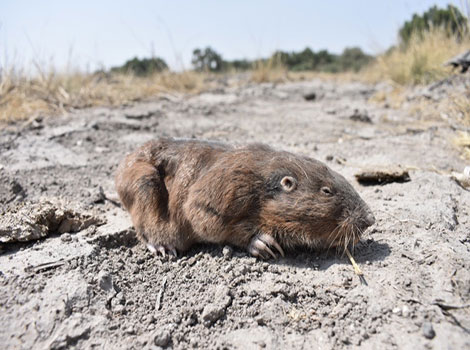
| Attributes | Quick facts |
|---|---|
| Size | 8–12 in (20–30 cm) |
| Weight | 0.8–1.5 lbs (350–700 g) |
| Lifespan | 2–5 years (estimated) |
| Habitat | Grasslands and agricultural fields in Querétaro, Mexico |
| Diet | Roots, tubers, and plant material |
| Social Structure | Solitary |
| Conservation | Endangered |
Fun Fact: The Queretaro Pocket Gopher can move several pounds of soil daily, helping aerate and fertilize the soil, benefiting the ecosystem!
16. Queensland Rat Kangaroos
The Queensland Rat Kangaroo (Bettongia tropica), a small marsupial in the Potoroidae family, inhabits the eucalypt woodlands and grasslands of Queensland, Australia. Measuring 12–16 inches (30–40 centimeters) in both body and tail length and weighing 2–5 pounds (0.9–2.3 kilograms), it thrives in warm, temperate climates with seasonal rainfall. Non-migratory by nature, it forages within its home range for food.
This marsupial features brownish-gray fur with a paler underbelly, blending into its grassy or wooded surroundings. Its prehensile tail aids in carrying nesting materials, while its strong hind legs help with movement. Nocturnal and solitary, it rests in grass and leaf nests by day and forages by night, digging for fungi, seeds, fruits, and roots. Females give birth to a single joey, which stays in the pouch for 3–4 months before nursing further and becoming independent by 8–10 months.
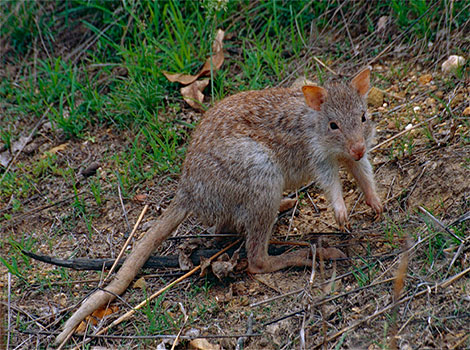
| Attributes | Quick facts |
|---|---|
| Size | 12–16 in (30–40 cm) body; tail 12–16 in (30–40 cm) |
| Weight | 2–5 lbs (0.9–2.3 kg) |
| Lifespan | 5–8 years in the wild, up to 12 years in captivity |
| Habitat | Eucalypt woodlands and grasslands in Queensland, Australia |
| Diet | Fungi, seeds, fruits, and roots |
| Social Structure | Solitary |
| Conservation | Endangered |
Fun Fact: Queensland Rat Kangaroos play a key role in forest health by dispersing fungal spores that aid tree nutrient absorption!
17. Qinling Panda
The Qinling Panda (Ailuropoda melanoleuca qinlingensis), a rare subspecies of giant panda, is native to the Qinling Mountains in central China. Measuring 5–6 feet (1.5–1.8 meters) in length and weighing 155–275 pounds (70–125 kilograms), these pandas inhabit temperate forests rich in bamboo, preferring cool, humid climates. While non-migratory, they move locally to access seasonal bamboo supplies.
Unlike the iconic black-and-white giant panda, Qinling Pandas have unique brown and light tan fur. Their stocky bodies and strong jaws are adapted for their bamboo diet, which constitutes over 99% of their food. They consume up to 26–84 pounds (12–38 kilograms) daily, using pseudo-thumbs to grasp bamboo stalks. Solitary by nature, they spend much of their time eating or resting and breed in spring. Females raise a single cub, which stays with them for up to 18 months before independence.
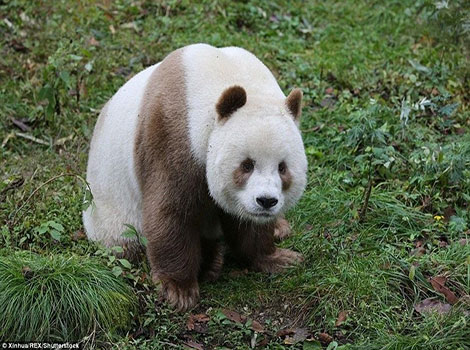
| Attributes | Quick facts |
|---|---|
| Size | 5–6 ft (1.5–1.8 m) in length; 2–3 ft (60–90 cm) at the shoulder |
| Weight | 155–275 lbs (70–125 kg) |
| Lifespan | 20–30 years |
| Habitat | Qinling Mountains in China; temperate forests with dense bamboo growth |
| Diet | Primarily bamboo; occasional small mammals or carrion |
| Social Structure | Solitary |
| Conservation | Endangered |
Fun Fact: With fewer than 350 individuals left in the wild, the Qinling Panda is the rarest panda subspecies, emphasizing the urgency of conservation efforts!
Having explored mammals that start with ‘Q,’ let’s delve into reptiles. These scaly creatures boast fascinating characteristics and are pivotal to many ecological systems.
Reptiles that start with Q
Reptiles beginning with ‘Q’ may be less common, but they include species like the Queensland lungfish. These animals highlight nature’s evolutionary ingenuity and survival strategies.
| Queretaran Desert Lizard | Queretaran Dusky Rattlesnake |
18. Queretaran Desert Lizard
The Queretaran Desert Lizard (Sceloporus spp.), a member of the Phrynosomatidae family, thrives in the arid and semi-arid regions of Querétaro, Mexico. Measuring 6–10 inches (15–25 centimeters) in length and weighing 1–2 ounces (28–56 grams), this robust lizard is well-adapted to hot, dry climates with rocky terrains and sparse vegetation. Non-migratory, it remains within its territory, roaming locally for food and shelter.
This lizard’s grayish-brown coloration, accented with darker bands or spots, provides excellent camouflage against desert rocks. Its spiny, keeled scales offer protection, and its long tail aids in balance and defense. An insectivore, it actively forages during the day, basking in the sun during cooler mornings and seeking shade in the afternoon. Females are oviparous, laying 4–8 eggs in burrows, with hatchlings fully independent at birth.
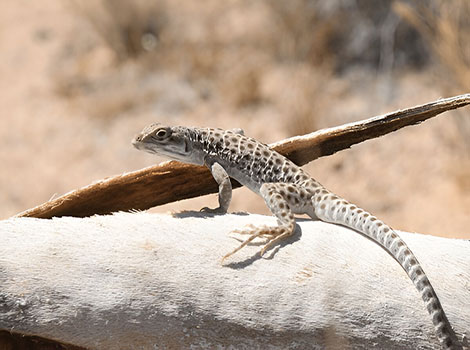
| Attributes | Quick facts |
|---|---|
| Size | 6–10 in (15–25 cm) |
| Weight | 1–2 oz (28–56 g) |
| Lifespan | 5–10 years |
| Habitat | Arid and semi-arid regions, including deserts and rocky outcrops in Querétaro, Mexico |
| Diet | Insects, spiders, and small invertebrates |
| Social Structure | Solitary |
| Conservation | Data Deficient |
Fun Fact: The Queretaran Desert Lizard is a skilled climber, expertly navigating steep, rocky surfaces in its rugged desert environment!
19. Queretaran Dusky Rattlesnake
The Queretaran Dusky Rattlesnake (Crotalus aquilus), a venomous member of the Viperidae family, is native to rocky hillsides, grasslands, and forests in Querétaro, Mexico. Measuring 18–24 inches (45–60 centimeters) in length and weighing 4–12 ounces (113–340 grams), this small to medium-sized rattlesnake thrives in temperate to semi-arid climates, where it finds shelter among rocks and dense vegetation.
Its gray or brown body, patterned with irregular dusky blotches, provides effective camouflage in its environment. Equipped with heat-sensing pits, it detects warm-blooded prey such as rodents, birds, and lizards. As an ambush predator, it lies in wait and strikes swiftly, injecting venom to subdue its prey. Solitary by nature, it is primarily active at dawn and dusk or during warmer nights. Females give birth to 4–12 live young, which are independent from birth.
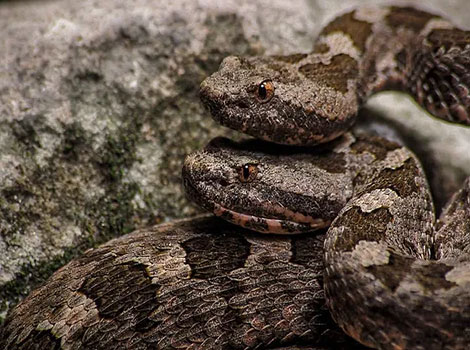
| Attributes | Quick facts |
|---|---|
| Size | 18–24 in (45–60 cm) |
| Weight | 4–12 oz (113–340 g) |
| Lifespan | 10–20 years |
| Habitat | Rocky hillsides, grasslands, and forests in Querétaro, Mexico |
| Diet | Small mammals, birds, and lizards |
| Social Structure | Solitary |
| Conservation | Near Threatened |
Fun Fact: Though small, the Queretaran Dusky Rattlesnake’s potent venom makes it an exceptionally skilled predator in its ecosystem!
Moving from reptiles, we now turn our attention to birds that start with ‘Q.’ These feathered wonders are known for their distinctive calls and striking appearances.
Birds that start with Q
Birds such as the quail and the quetzal are well-known examples that start with ‘Q.’ These species showcase vibrant plumage and play essential roles in their habitats.
| Quelea | Quarrion | Quail Dove |
| Quailfinch | Queen Charlotte Goshawk | Quail Hawk |
20. Quelea
The Quelea (Quelea quelea), a member of the Ploceidae family, is a small seed-eating bird found across sub-Saharan Africa’s grasslands, savannas, and agricultural areas. Measuring 4.7–5.1 inches (12–13 centimeters) in length and weighing 0.5–0.8 ounces (15–20 grams), these birds thrive in warm, dry climates with seasonal rainfall to support grass and seed growth. Highly migratory, Queleas travel vast distances in search of food and water.
During the breeding season, males display striking red faces, while females and non-breeding males are duller for camouflage. Their sturdy, conical beaks are ideal for cracking seeds, their primary diet, though they also consume insects during breeding for extra protein. Extremely social, Queleas form massive flocks numbering in the millions, often causing significant agricultural damage as they forage. They nest in colonies, with both parents feeding the chicks until they fledge at 10–14 days old.
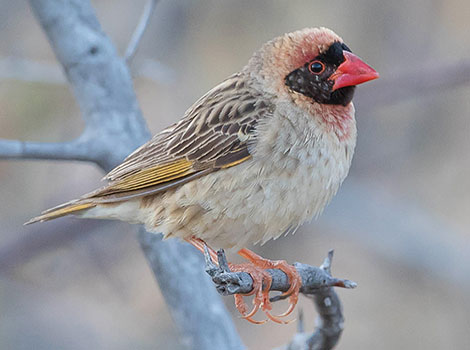
| Attributes | Quick facts |
|---|---|
| Size | 4.7–5.1 in (12–13 cm) |
| Weight | 0.5–0.8 oz (15–20 g) |
| Lifespan | 2–3 years in the wild |
| Habitat | Grasslands, savannas, and agricultural areas in sub-Saharan Africa |
| Diet | Seeds and grains; occasionally insects |
| Social Structure | Highly social; forms flocks of millions during migration and feeding |
| Conservation | Least Concern |
Fun Fact: Known as the “feathered locust,” the Red-billed Quelea is among the most abundant bird species on Earth, with flocks capable of consuming entire fields of crops!
21. Quarrion
The Quarrion (Nymphicus hollandicus), also known as the Cockatiel, is a small parrot in the Cacatuidae family, native to Australia. Measuring 12–13 inches (30–33 centimeters) in length and weighing 2.5–4 ounces (70–110 grams), these birds thrive in open woodlands, grasslands, and arid regions, often near water sources. Adaptable to dry, warm climates, Quarrions are nomadic and travel in flocks to find food and water.
Typically gray with a yellow face and orange cheek patches, males are more vibrant, while females and juveniles appear duller. Their prominent yellow crests are used for communication and display. Granivorous by nature, Quarrions feed primarily on seeds, supplemented with fruits and grasses, and forage on the ground or in trees. Social and diurnal, they live in flocks of varying sizes, spending their days feeding and socializing. Breeding in tree hollows, both parents care for chicks, which fledge at 4–5 weeks.
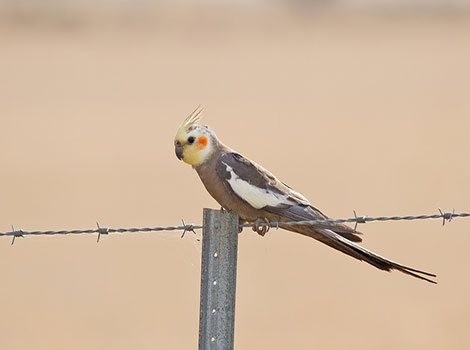
| Attributes | Quick facts |
|---|---|
| Size | 12–13 in (30–33 cm) |
| Weight | 2.5–4 oz (70–110 g) |
| Lifespan | 10–15 years in the wild; up to 25 years in captivity |
| Habitat | Open woodlands, grasslands, and arid regions in Australia |
| Diet | Seeds, fruits, and occasional insects |
| Social Structure | Highly social; lives in flocks |
| Conservation | Least Concern |
Fun Fact: The Quarrion is the smallest cockatoo and a popular pet known for its ability to mimic sounds and whistles!
22. Quail Dove
The Quail Dove (Geotrygon spp.) is a medium-sized bird in the Columbidae family, found in forests and woodlands across the Caribbean, Central America, and northern South America. Measuring 9–13 inches (23–33 centimeters) in length and weighing 4.5–7 ounces (130–200 grams), these doves thrive in warm, humid environments with dense understory vegetation. While non-migratory, they may move locally in search of food.
Quail Doves are known for their stunning iridescent plumage, often featuring green, bronze, or purple hues on the head and back, contrasting with lighter underbellies. Adapted for ground foraging, they have strong legs for scratching through leaf litter and a slender beak for picking seeds, fruits, and small invertebrates. Typically solitary or in pairs, they spend their days foraging and resting in shrubs or trees. Breeding involves both parents sharing incubation and feeding duties, with chicks fledging in 2–3 weeks.
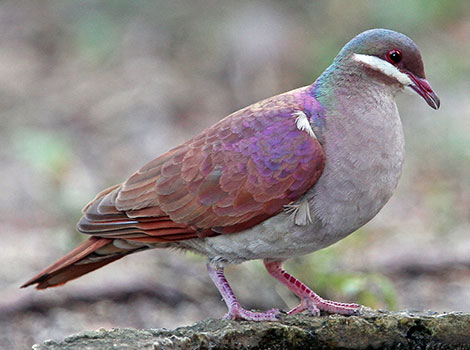
| Attributes | Quick facts |
|---|---|
| Size | 9–13 in (23–33 cm) |
| Weight | 4.5–7 oz (130–200 g) |
| Lifespan | Estimated 5–10 years |
| Habitat | Forests and woodlands in the Caribbean, Central America, and northern South America |
| Diet | Seeds, fruits, and small invertebrates |
| Social Structure | Solitary or pairs |
| Conservation | Least Concern |
Fun Fact: Quail Doves are elusive and shy, more often heard than seen, with their mournful cooing calls echoing through the forest!
23. Quailfinch
The Quailfinch (Ortygospiza atricollis), a small seed-eating bird in the Estrildidae family, is native to grasslands, savannas, and wetlands across sub-Saharan Africa. Measuring 4–5 inches (10–12 centimeters) in length and weighing 0.3–0.4 ounces (9–12 grams), these birds thrive in warm, tropical climates with seasonal rainfall. Though non-migratory, they may move locally in search of food and water.
Quailfinches have gray to brown plumage with white barring on their underparts, while males feature a distinctive black face and throat. Their short, conical beaks are perfect for cracking seeds, and they forage on the ground in small groups, supplementing their diet with insects during the breeding season. Social by nature, they live in pairs or small flocks and build dome-shaped grass nests, where females lay 3–6 eggs. Both parents feed the chicks, which fledge after about three weeks.
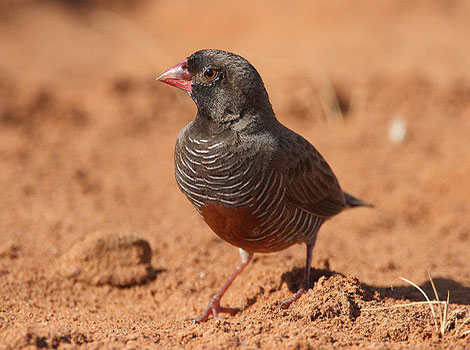
| Attributes | Quick facts |
|---|---|
| Size | 4–5 in (10–12 cm) |
| Weight | 0.3–0.4 oz (9–12 g) |
| Lifespan | 5–8 years |
| Habitat | Grasslands, savannas, and wetlands in sub-Saharan Africa |
| Diet | Seeds and small insects |
| Social Structure | Lives in pairs or small flocks |
| Conservation | Least Concern |
Fun Fact: True to their name, Quailfinches are skilled runners, often scurrying through grass like quails rather than taking flight!
24. Queen Charlotte Goshawk
The Queen Charlotte Goshawk (Accipiter gentilis laingi), a subspecies of the Northern Goshawk, is a medium-sized raptor native to the temperate rainforests of Haida Gwaii and nearby regions in British Columbia, Canada. Measuring 20–25 inches (50–63 centimeters) in body length, with a wingspan of 38–46 inches (97–117 centimeters) and a weight of 1.3–2.9 pounds (600–1,300 grams), it thrives in cool, wet environments with dense forest canopies. While non-migratory, it may move locally to find food or suitable breeding sites.
This bird of prey has slate-gray upperparts and white underparts with dark barring as an adult, while juveniles are brown with streaked underparts. Its long tail and broad wings allow exceptional agility for hunting in dense forests. Carnivorous, it preys on birds, small mammals, and occasionally reptiles, using stealth and speed to ambush its prey. Solitary outside the breeding season, it nests high in trees, with both parents raising 2–4 chicks until they fledge at 35–40 days.
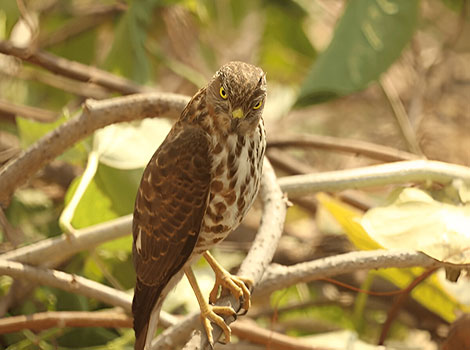
| Attributes | Quick facts |
|---|---|
| Size | 20–25 in (50–63 cm) body; wingspan 38–46 in (97–117 cm) |
| Weight | 1.3–2.9 lbs (600–1,300 g) |
| Lifespan | 10–20 years |
| Habitat | Temperate rainforests in the Queen Charlotte Islands (Haida Gwaii) and surrounding regions of British Columbia, Canada |
| Diet | Birds, small mammals, and reptiles |
| Social Structure | Solitary except during breeding |
| Conservation | Near Threatened |
Fun Fact: The Queen Charlotte Goshawk is a master of forest navigation, making sharp turns mid-flight to catch prey in dense woodland!
25. Quail Hawk
The Quail Hawk (Falco novaeseelandiae), known as the “Kārearea” in Māori, is New Zealand’s only native falcon and a symbol of strength and freedom. This medium-sized raptor measures 15–20 inches (38–50 centimeters) in length, with a wingspan of 30–36 inches (76–91 centimeters) and a weight of 0.9–2 pounds (400–900 grams). It inhabits forests, shrublands, and grasslands, thriving in temperate climates from coastal lowlands to alpine regions. Non-migratory by nature, it may move to lower altitudes during winter.
The Quail Hawk’s dark brown plumage with a streaked underside aids its camouflage. It has sharp, hooked beaks and long, pointed wings designed for speed and precision. A carnivorous hunter, it preys on birds, small mammals, and insects, often catching prey mid-air or swooping to the ground. Solitary except for breeding, it nests in remote cliffs, trees, or ground areas, with both parents raising chicks until they fledge after 5–6 weeks.
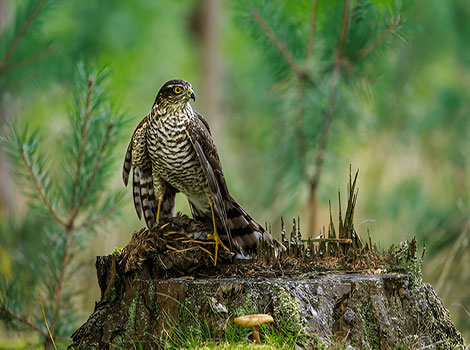
| Attributes | Quick facts |
|---|---|
| Size | 15–20 in (38–50 cm); wingspan 30–36 in (76–91 cm) |
| Weight | 0.9–2 lbs (400–900 g) |
| Lifespan | 10–15 years |
| Habitat | Forests, shrublands, and open grasslands in New Zealand |
| Diet | Birds, small mammals, and insects |
| Social Structure | Solitary except during breeding |
| Conservation | Near Threatened |
Fun Fact: Revered in Māori culture, the Quail Hawk is celebrated for its agility and strength, making it a true emblem of New Zealand’s wildlife.
After admiring the elegance of birds, we’ll dive underwater to explore fish that start with ‘Q.’ These aquatic creatures are equally mesmerizing in their environments.
Fish that start with Q
Fish beginning with ‘Q,’ such as the Queensland grouper, demonstrate the incredible diversity of marine life, thriving in oceans and freshwater systems alike.
| Queen Snapper | Queen Tiger Fish | Quillback Rockfish |
26. Queen Snapper
The Queen Snapper (Etelis oculatus), a striking deep-sea fish in the Lutjanidae family, inhabits warm, tropical waters of the Atlantic Ocean, particularly the Caribbean Sea and Gulf of Mexico. Measuring 24–36 inches (60–90 centimeters) in length and weighing 8–12 pounds (3.6–5.4 kilograms), this species is found at depths of 200–500 meters. Non-migratory, it may move vertically within the water column based on food availability and light conditions.
With a bright red body and large, reflective eyes adapted to low-light environments, the Queen Snapper boasts a streamlined shape, forked tail, and sharp teeth. It is a carnivorous predator, feeding on fish, squid, and crustaceans. Typically forming small schools, it actively hunts during specific times of the day. Spawning occurs in open water, with eggs developing into planktonic larvae that drift before settling into deep waters as juveniles.
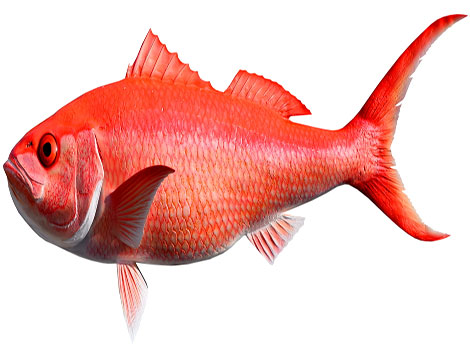
| Attributes | Quick facts |
|---|---|
| Size | 24–36 in (60–90 cm) |
| Weight | 8–12 lbs (3.6–5.4 kg) |
| Lifespan | 15–20 years |
| Habitat | Deep waters (200–500 m) in the Atlantic Ocean, especially around the Caribbean and Gulf of Mexico |
| Diet | Fish, squid, and crustaceans |
| Social Structure | Small schools or solitary |
| Conservation | Least Concern |
Fun Fact: Renowned for its mild and delicate flavor, the Queen Snapper is a prized catch in deep-sea commercial and recreational fishing!
27. Queen Tiger Fish
The Queen Tiger Fish (Hydrocynus spp.) is a predatory freshwater fish in the Alestidae family, native to tropical rivers, lakes, and reservoirs across Africa, including the Congo and Zambezi River basins. Measuring 12–24 inches (30–60 centimeters) in length and weighing 5–20 pounds (2.3–9 kilograms), it thrives in oxygen-rich waters of warm, tropical climates. While non-migratory, it may move within river systems based on water levels and prey availability.
With a streamlined silvery body, faint vertical stripes, and a yellowish or reddish tail, the Queen Tiger Fish is built for speed and power. Its sharp, conical teeth and swift movements make it an effective ambush predator, feeding on smaller fish, insects, and aquatic invertebrates. Typically solitary, it becomes more social during feeding. Spawning occurs during the rainy season, with eggs hatching in calm waters where fry find shelter.
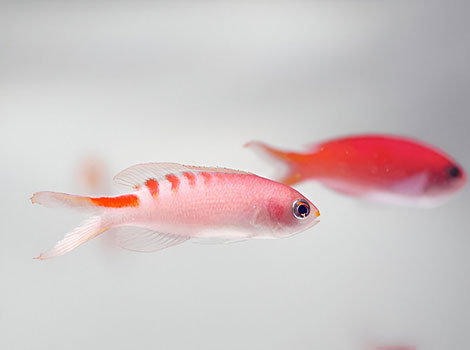
| Attributes | Quick facts |
|---|---|
| Size | 12–24 in (30–60 cm), varies by species |
| Weight | 5–20 lbs (2.3–9 kg) |
| Lifespan | 8–15 years |
| Habitat | Freshwater rivers and lakes in tropical Africa |
| Diet | Carnivorous; feeds on smaller fish and aquatic invertebrates |
| Social Structure | Solitary or small groups |
| Conservation | Least Concern |
Fun fact: Renowned for its strength and agility, the Queen Tiger Fish is a sought-after sport fish, challenging anglers with its impressive speed and fighting spirit!
28. Quillback Rockfish
The Quillback Rockfish (Sebastes maliger), a member of the Sebastidae family, is native to the rocky reefs and kelp forests of the northeastern Pacific Ocean, ranging from Alaska to California. Measuring 12–24 inches (30–60 centimeters) in length and weighing 2–5 pounds (0.9–2.3 kilograms), this fish thrives in cool, temperate marine environments and remains near specific rocky habitats throughout its life.
With a deep body, sharp dorsal spines resembling quills, and dark brown to black coloration mottled with orange or yellow, the Quillback Rockfish blends seamlessly into its environment. These spines, which are venomous, provide defense against predators. A carnivorous ambush predator, it feeds on crustaceans, small fish, and plankton. Solitary by nature, it stays close to the ocean floor, ambushing prey near rocky crevices. Viviparous females give birth to thousands of free-swimming larvae, which drift before settling into rocky habitats as juveniles.
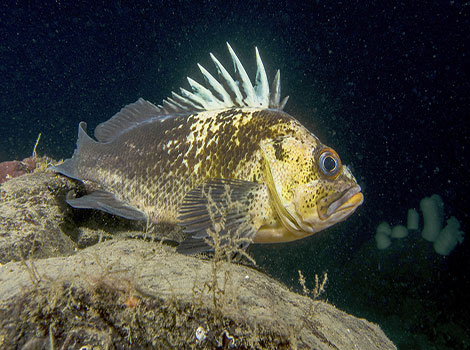
| Attributes | Quick facts |
|---|---|
| Size | 12–24 in (30–60 cm) |
| Weight | 2–5 lbs (0.9–2.3 kg) |
| Lifespan | Up to 95 years |
| Habitat | Rocky reefs and kelp forests in the northeastern Pacific Ocean |
| Diet | Crustaceans, small fish, and plankton |
| Social Structure | Solitary |
| Conservation | Vulnerable |
Fun Fact: The Quillback Rockfish can live up to 95 years, making it one of the longest-lived fish species, but its slow growth and late maturity make it especially vulnerable to overfishing.
From the watery depths, we transition to insects that start with ‘Q.’ These creatures are perfectly adapted to life both in water and on land.
Insects that start with Q
Insects like the queen bee and the queen ant stand out as remarkable examples of species that start with ‘Q,’ displaying complex social behaviors and environmental significance.
| Quinoa Checkerspot Butterfly | Queen Bee | Queen Alexandra’s Birdwing Butterfly |
29. Quinoa Checkerspot Butterfly
The Quinoa Checkerspot Butterfly (Euphydryas spp.), a member of the Nymphalidae family, inhabits high-altitude grasslands in South America, particularly areas where quinoa plants grow. With a wingspan of 1–1.5 inches (2.5–3.8 centimeters) and weighing under 0.01 ounces (0.3 grams), these small butterflies thrive in cool, temperate climates. They remain near host plants, such as quinoa (Chenopodium quinoa), essential for their survival.
Their wings display vibrant orange, black, and white checkered patterns, serving as both camouflage and predator deterrence. Caterpillars feed on quinoa leaves, while adults rely on nectar from wildflowers, using their long, clubbed antennae for navigation. These diurnal butterflies are solitary, basking in the sun and foraging during warm periods. Females lay eggs on quinoa leaves, with caterpillars developing independently after hatching.
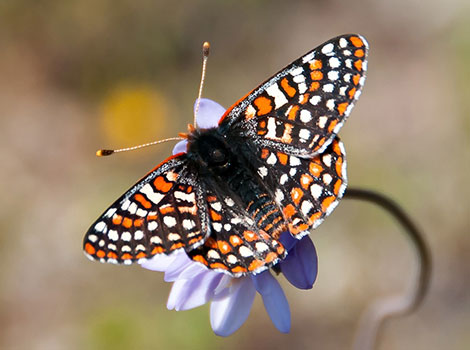
| Attributes | Quick facts |
|---|---|
| Size | Wingspan 1–1.5 in (2.5–3.8 cm) |
| Weight | Less than 0.01 oz (under 0.3 g) |
| Lifespan | Few weeks as adults |
| Habitat | High-altitude grasslands in South America, particularly near quinoa plants |
| Diet | Caterpillars feed on quinoa and other related plants; adults feed on nectar |
| Social Structure | Solitary |
| Conservation | Data Deficient |
Fun Fact: The Quinoa Checkerspot Butterfly is vital to its ecosystem, pollinating flowers and naturally regulating quinoa plant growth, ensuring balance in high-altitude environments!
30. Queen Bee
The Queen Bee (Apis mellifera), a central figure in honeybee colonies, belongs to the Apidae family, which includes bees, bumblebees, and stingless bees. Measuring 0.8–0.9 inches (20–23 millimeters) in length and weighing around 0.02 ounces (0.5 grams), the queen resides within the hive, thriving in climates ranging from temperate to tropical zones. Non-migratory, she stays in the hive unless leading a swarm or during colony relocation.
Distinguished by a darker color and elongated abdomen, the Queen Bee is larger and more slender than worker bees. Her life revolves around reproduction, laying up to 2,000 eggs daily, and maintaining hive cohesion through pheromones. Unlike worker bees, she does not forage and is exclusively fed nutrient-rich royal jelly by her attendants. Fertilized eggs develop into workers or queens, while unfertilized ones produce drones. Care for eggs and larvae is managed entirely by worker bees.
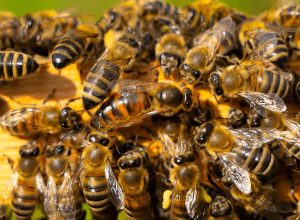
| Attributes | Quick facts |
|---|---|
| Size | 0.8–0.9 in (20–23 mm) |
| Weight | Approximately 0.02 oz (0.5 g) |
| Lifespan | 1–5 years |
| Habitat | Beehives; found globally where honeybee colonies exist |
| Diet | Fed exclusively on royal jelly |
| Social Structure | Central figure in a colony; sole egg-laying individual |
| Conservation | Data Deficient |
Fun Fact: The Queen Bee’s pheromones are vital for hive harmony, controlling worker behavior, hive maintenance, and the timing of swarming!
31. Queen Alexandra’s Birdwing Butterfly
The Queen Alexandra’s Birdwing Butterfly (Ornithoptera alexandrae) is the largest butterfly in the world, belonging to the Papilionidae family. With a wingspan of 9–12 inches (23–30 centimeters) and weighing 0.4–0.6 ounces (12–16 grams), it is native to the lowland rainforests of Papua New Guinea’s Oro Province. Thriving in warm, humid tropical climates, this butterfly is non-migratory, remaining near its host plants.
Males showcase striking blue, green, and black wings, while larger females feature brown and cream-colored wings with white markings. Adapted for powerful flight, their long, coiled proboscis allows them to sip nectar from rainforest flowers. Larvae feed on the toxic leaves of Aristolochia plants, gaining chemical defenses against predators. Solitary and diurnal, males patrol for mates while females lay eggs on host plants, where larvae develop independently through several instars before pupating.
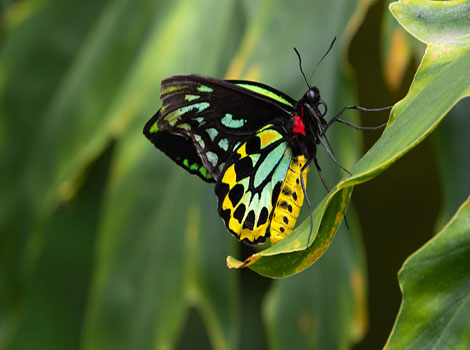
| Attributes | Quick facts |
|---|---|
| Size | Wingspan 9–12 in (23–30 cm) |
| Weight | 0.4–0.6 oz (12–16 g) |
| Lifespan | 3–4 months (adult stage) |
| Habitat | Lowland rainforests in Papua New Guinea |
| Diet | Nectar from flowers (adults); host plants like Aristolochia (larvae) |
| Social Structure | Solitary |
| Conservation | Endangered |
Fun Fact: Named after Queen Alexandra of England, this butterfly’s immense size and rarity make it iconic, but habitat destruction and overcollection have rendered it critically endangered.
FAQs
What are Zoo Animals that Start With Q?
The quokka (Setonix brachyurus) is the only zoo animal that starts with Q. This small marsupial found in Western Australia. While not commonly seen in zoos outside Australia, some zoos and wildlife parks may have quokkas in their collections. Quokkas are known for their friendly and curious nature and have become famous for their seemingly smiling facial expressions.
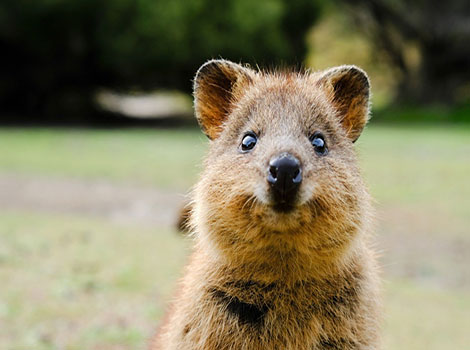
What is a happy animal that starts with Q?
The quokka (Setonix brachyurus) is often described as a happy animal. Quokkas have a friendly and curious nature, and their facial expressions often look like a smile, leading them to be called “the world’s happiest animal.” It is a small marsupial found in Western Australia, particularly on Rottnest Island and some parts of the mainland.
Their seemingly cheerful demeanor has made them popular subjects for selfies and social media posts. It’s important to note that while they may appear happy, they are still wild animals and should be treated with respect and kept at a safe distance to ensure their well-being.
What are Spanish animals that start with Q?
The quebrantahuesos, also known as the Lammergeier or Bearded Vulture (Gypaetus barbatus), is a large bird of prey native to the mountainous regions of Spain, including the Pyrenees. It is known for its impressive size, wingspan, and distinctive appearance: its dark body, a feathered “beard” around its face, and a bright yellow beak. The quebrantahuesos are an essential symbol of conservation efforts in Spain and are considered a threatened species.
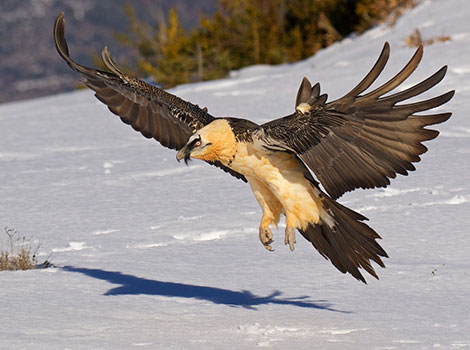
What is the animal that starts with Q in South Africa?
Here are 3 animals that start with Q in South Africa:
- Quagga: The quagga (Equus quagga quagga) was a subspecies of plains zebra native to South Africa. However, it became extinct in the late 19th century. Efforts are underway to reintroduce a similar-looking animal called the “Rau quagga” through selective breeding.
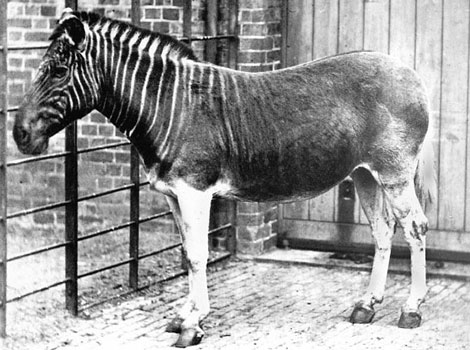
- Quail: Quails are bird species belonging to the family Phasianidae. In South Africa, the common quail (Coturnix coturnix) and the Harlequin quail (Coturnix delegorguei) can be found. Birdwatchers frequently seek out these small, ground-dwelling birds because of their distinctive calls.
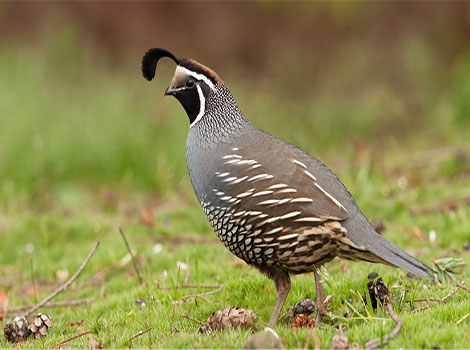
What are the extinct animals that start with Q?
Here are two extinct animals that start with Q:
- Quagga: The quagga (Equus quagga quagga) was a subspecies of plains zebra native to South Africa. It had a unique coat pattern with stripes on its head and neck, while the rest resembled a horse’s body. The last known individual died in captivity in 1883, and the quagga was declared extinct shortly after that.
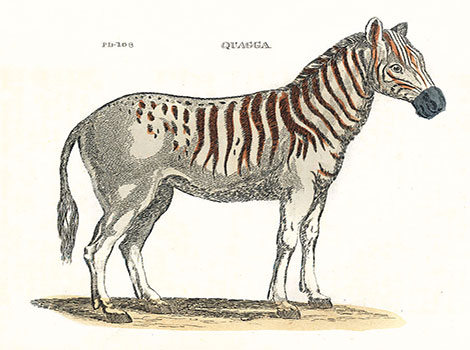
Quinkana: Quinkana is an extinct genus of crocodile that lived in Australia during the Pleistocene epoch. It was a large predator and is often called the “terminator crocodile.” Quinkana species had a robust build with powerful jaws and sharp teeth. Fossil evidence suggests that they were terrestrial predators, preying on various animals.
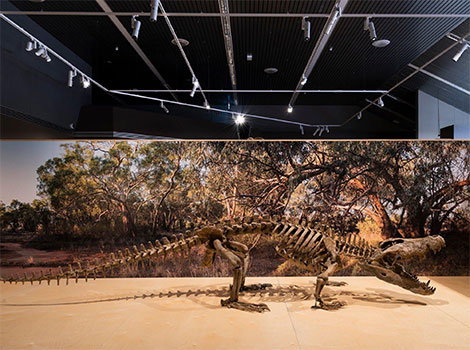
Exploring animals that start with the letter “Q” reveals a fascinating collection of creatures, each with its own unique traits and stories. From the quirky Quokka to the elusive Quail, these animals remind us of the diversity and wonder found in nature. Each species plays a vital role in its ecosystem, contributing to the intricate balance of life on Earth. By learning about these remarkable creatures, we nurture a deeper respect for the natural world and the importance of conserving it for future generations.
If you’re searching for animal names starting with a different letter, explore our other comprehensive articles dedicated to animal names.
